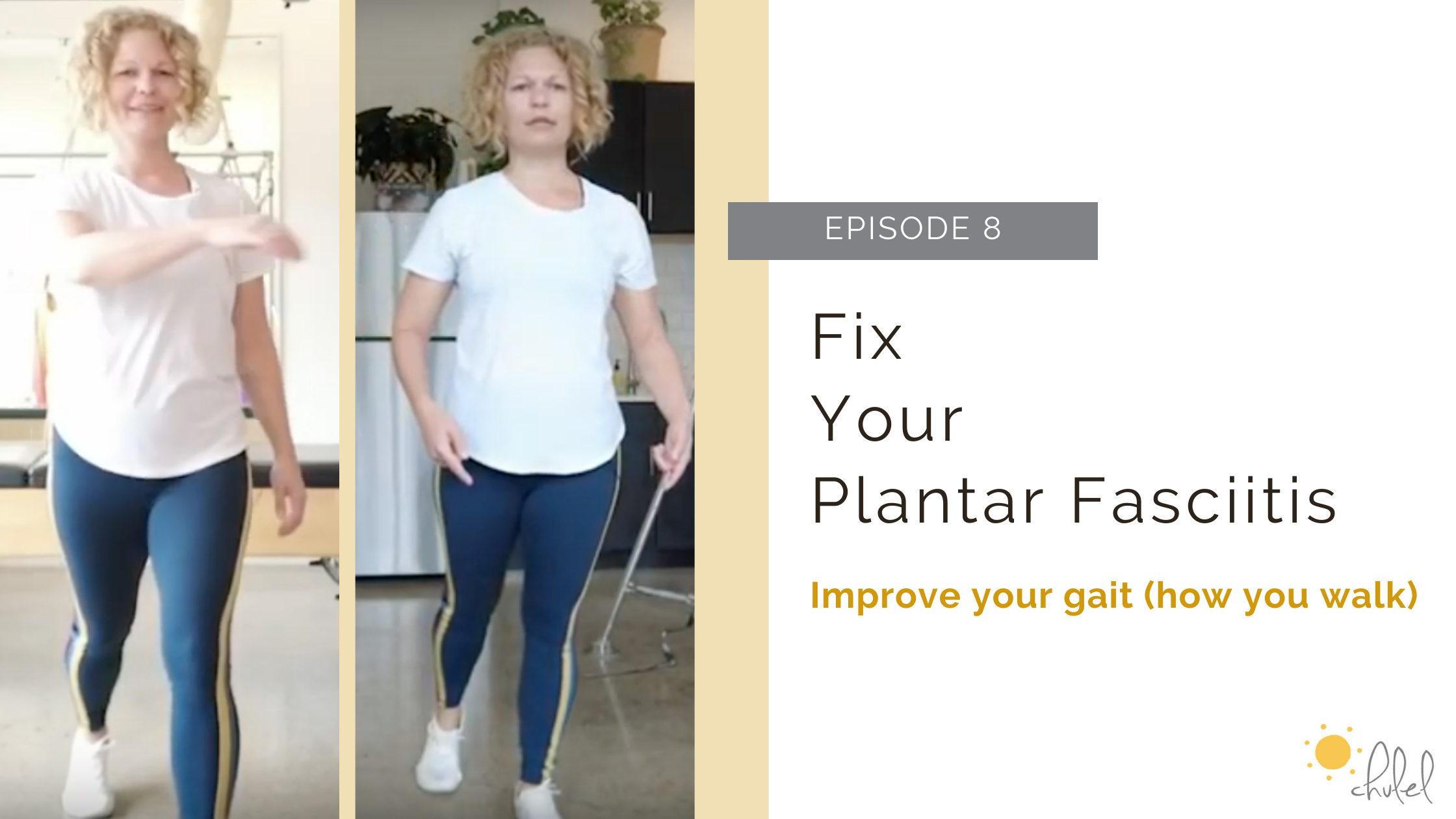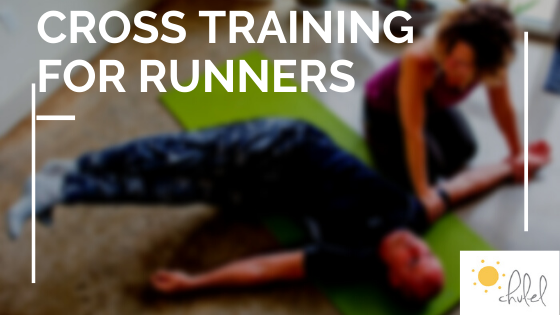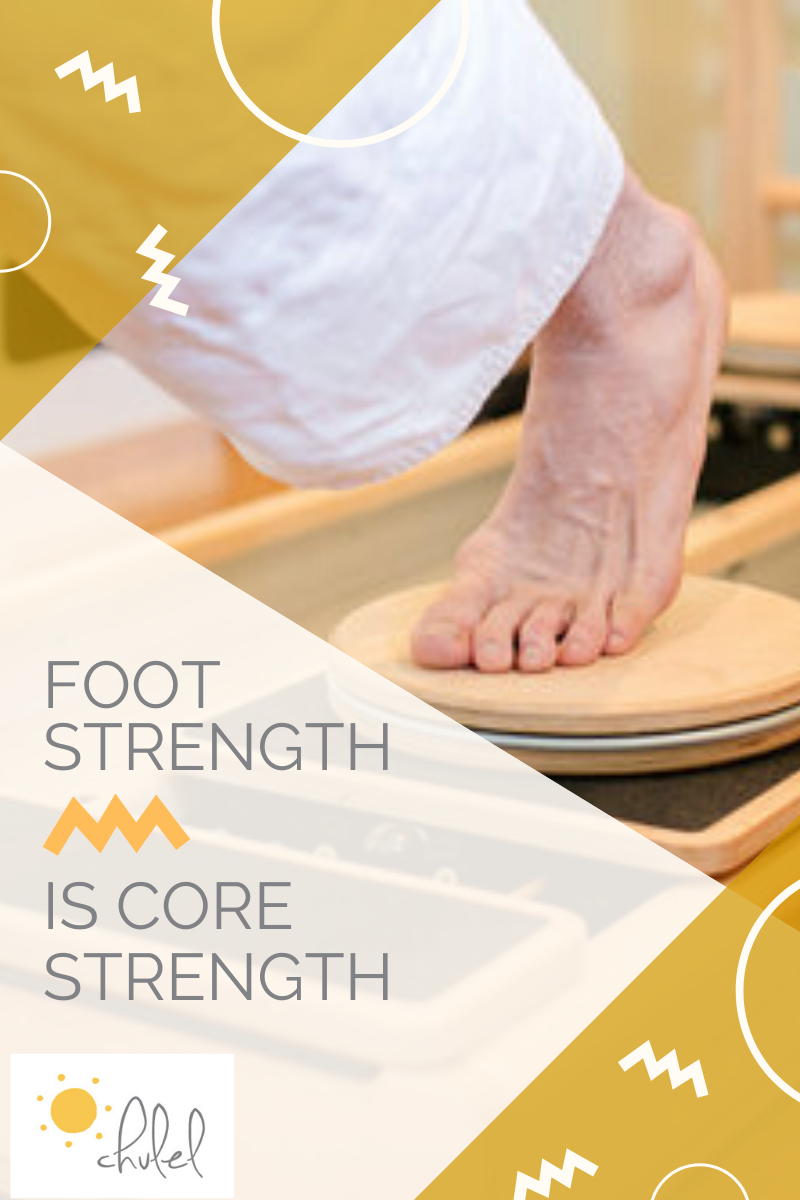Your Custom Text Here
Fix Your Plantar Fasciitis-Episode 8 How to Improve Your Gait
Over the years I’ve taken several workhops and read many books on how to fix your gait (how you walk/run) to correct several injuries I’ve had to my lower leg—including being hit by a car in a crosswalk.
This video highlights some of my favorite exercises I’ve learned that can be done from anywhere.
The first is from an Aston Patterning workshop that trains your body how to transfer weight from one leg up through the pelvis to the other leg. I always liken it to feeling like you have a slinky momentum as you walk. I’ve noticed that those with plantar fasciitis, tight feet, even bunions and Morten’s neuroma don’t fully roll through their midarch when they roll through their foot. It’s more of a heel-toe clomp. This simple exercise can help your body improve balance and change that pattern.
The next couple of exercises are from a workshop I took with James Earls who wrote a book called Born to Walk. They emphasize a fascial spring to walking and really hone in on the rotation aspect of walking. This is another plantar fasciitis thing—that gait pattern can often be more of a waddle instead of there being a subtle twist of the upper body on the lower body with each stride.
Lastly, we look to deepening the feeling of that twist with a connection to the diaphragm. This is a good, little balance challenge.
I recommend doing these on a longer walk or a run to let your tissues get into the flow and so that the new pattern can set into your tissues.
Common Cause of Knee & Ankle Pain
TIGHT TOES! Take a little walk—long enough to get your stride and pace going and notice if you feel your ankle roll out to the side just a little bit as you push off. You may even feel a twinge of pain in your ankle or knee. Another option is to get someone to video you (maybe even in slow motion) and see if you can watch yourself doing it. It will look like a little ankle whip around as you propel forward as in the picture below.
How would the toes get tight?
The top two reasons from my experience with clients are shoe selection and not breathing fully. Any shoe that encourages a toe scrunch would create a situation where your body would start tighten when walking instead of being wide and open (I refer to this preferred state as ‘Frodo Feet’). This isn’t just the easy scapegoat of high heels and pointy shoes, flip flops or any shoe that is so loose that your toes have to work to keep them on would create tight toes. Wearing shoes that are too small or lacing shoes too tightly would cause similar footing.
Next, hold your breath and feel how your feet tighten up a bit (all your muscles, really). We all have a tendency to shallow breathe when we feel stressed, so being under prolonged stress or if you’re in a job/school environment where you heavily focus day-to-day, usually means that you’re holding your breath. I often see that if someone grew up in an environment where they were often afraid or anxious (this could also translate into present-tense adulthood) the toes also scrunch as a response to that fear factor. I call it the Bird-on-a-Wire grip whereas that Frodo Foot is grounded and open…calm.
How should I walk?
This goes with a bit of an * in that we’re all shaped differently and have varied movement/injury backgrounds so there isn’t one for sure right way. That said, the first two toes (big toe and second toe) should more or less line up with your shin bone and thigh bone. This may be difficult if you have flat arches or have had other lower leg injuries. These bones are considered your weight-bearing bones so your body weight is centered over the mid-line of your body. Your weight centered here would naturally allow your core and posture muscles to support you as you walk or run. Lack of weight-centering can cause weight to shift to the outer or lateral lines of the body in walking, which could be a factor in a tight IT band, lower back pain, knee pain and ankle issues.
As you take a step forward, the foot should roll through the mid arch to push off with the ball of foot and then the toes. If you have a tight first or second toe and/or a bunion, you are likely not pushing off of that foot correctly and you may be rolling to the outside of the foot as shown in the picture above.
An exercise to stretch your toes and allow for proper toe push off.
This simple stretch can be done with a rolled up towel or a tennis/lacrosse ball against a wall. In the video, my model is demonstrating it with one of my favorite foot stretching and release tools, the Yamuna Foot Savers. Here’s another way they can be used to release foot tension and help with plantar fasciitis. You can easily purchase them online through Amazon and they last forever. Take them with you when you travel because they take up virtually space and really help loosen the feet after sitting in a car or being in a plane for long periods of time. If you do have a bunion and this stretch feels uncomfortable, you can stretch your big toe off to the side and focus on your second toe. No need to do more than about 10ish repetitions on any given toe and only about once per day at most.
Happy, grounded feet=better balance and core stability!
Cross Training for Runners
We are deep in marathon-training season here in Texas thanks to temperatures that make outdoor activity easier. It's also a season when logging high mileage can lead to poor movement patterns and then injury. Using a combination of massage, trigger point therapy, stretching and strength training can not only keep you inury-free, it can also improve time and performance on the road.
This is a collection of some of my favorite stretches and exercises for runners, particularly for folks who stare at a screen for a living and love running for cardiovascular and mental health. As someone who is a bit 'Type A' I love my exercise and stretching routines to have twofers or threefers meaning you're getting multiple benefits from each. We're all busy so we might as well feel like we're accomplishing a few things at once from our stretching routines.
Massage & Trigger Point Release
We could all use to take better care of our feet, especially if you're out pounding the pavement for miles every week. Consider this massage like foam rolling for your feet. It only takes a couple of minutes and is easy to do while watching tv or before you pop on those shoes for a jog. Check and see if your foot changes color after you do it!
Trigger Point
The gist of trigger point work, if you have not heard of it before, is that you find a tender spot and apply consistent pressure until the muscle starts to relax. This can take minutes and can be confusing at first if you can't feel the muscles releasing. The more you practice the easier it is to know when the muscle is letting go. You can use a ball, foam roller or other trigger point therapy tool--my only reminder is to breathe! Below are two different releases you can do with a ball and a foam roller.
Piriformis (hip rotation) Trigger Point Release
Gluteal (butt) Muscle Trigger Point
Calf Trigger Point Release
Stretching
If you want to up your stretching routine and do something beyond the basic quad and calf stretch you learned in grade school, these are my favorites for stretching multiple places at one time. They incorporate stretching muscles as well as facial or connective tissue lines. Many runners may be aware that their calves and hamstrings could use a stretch (find my favorite version here), but knowing how to stretch the front of the shins is a bit more complicated. Click here for my suggestion for a good shin stretch.
Strengthening Exercises
When you're spending so much time on the road just trying to get your mileage in, stretching may be the only thing you may take time to do. Cross training exercises are soooo important for runners as you're doing a highly repetitive action. This plus long hours potentially looking at a screen usually means the hip muscles become weak because they're being supported by a chair most of the day. Hip weakness combined with high mileage is a recipe for chronic pain or an injury. Most runners I've worked with need more lateral (abductor) strength, inner thigh (adductor) strength as well as core stability via the obliques.
Strengthen You Rear
Inner Thigh Stretch and Strengthening
When looking at a screen most hours of the day and then participating in exercise that is also very forward-oriented, the obliques and the cross body stability muscles become weak. Improving these means improving balance so your energy can carry you forward. An added bonus is that you may even see your waistline shrink if you work on these muscles. Here's a simple, yet super challenging one using a foam roller.
Core Strengthening and Stability
How I can help
Ki Hara active stretching (see example here) is super effective in creating flexibility and strength at the same time. Having this muscular dexterity not only allows you to run longer, but also faster. Many professional athletes and sports teams across the country use this technique as their secret weapon.
I also use a piece of equipment called the CoreAlign that is phenomenal for gait training and orienting the body to the core in a running motion (see more about it here). I've helped many marathoners streamline their gait patterns so they can lower their per mile time. If you've ever, even as a teen, had an injury to the lower half of your body, you may have established some compensation patterns in your walk. Running with these compensation patterns can be an underlying component to chronic pain and injury. Peeling back those patterns will give you more agility and speed as you run. You have more power than you realize!!
Core Strength: More Than the Abs
How strong is your core? Did you just suffer a flashback of sit-ups combined with an internal sigh of how you should do more of them? I have great news for you....you don't need to do crunches to strengthen your core! There is an overemphasis in popular culture that a strong core=strong abs, but this is an outdated view.
What is the core?
I see the core as much more than abs--it's all of the muscles that keep us upright. As we're typically seated, hunched over a screen or steering wheel in the 21st century, the back muscles, pelvic floor (including the butt muscles) and diaphragm are aspects of the core we need to focus on. These other areas help support our spine, encourage good posture as well as give us full breath.
A fascial approach to the core.
When I'm assessing what areas need attention in a client's body, I'm always thinking about fascial, or connective tissue, lines. This means that an area where you feel tension could actually be originating from another spot in the body on a particular fascial line. So it's not always about muscle strength or weakness, but rather, what areas of the body are locked short and which areas are locked long. In other words, what areas need more length and which need more tone? If we take this global apporach to posture, most adults are locked short in the front from being hunched over and locked long, fascially, in the back. So why would we do a ton of sit-ups or flexion-based exercises thinking we're strengthening our core?!
Pilates and the core.
I love Pilates, otherwise I wouldn't have been certified to teach it, yet I feel like the method overemphasizes working the core in spinal flexion (the spine is bent over in a "C" shape). Moreover, much of Pilates is done while laying down, which is great for feeling core connections, yet there needs to be a functional application since we don't go about our day lying down. Joseph Pilates created his method several generations ago when our day-to-day lives were very different. I think an updated approach to his program means building back strength first, which passively stretches that front fascial line, making us straighter. Then, we can look at an abdominal or front-body approach to the core once those muscle tissues are not locked short and scrunched.
A unique approach to core strength.
I have my clients do a lot of work that hones in on the diaphragm and pelvic floor as a part of building their core. We also do a lot with the upper back muscles to pull the shoulders out of kyphosis (being rounded forward). I do this with some unique props that force you to balance while working your core and a piece of equipment that incorporates standing movmements so you're learning how your core supports you while upright and walking. This approach is not only more functional, it's more fun!
For the month of January I'm offering a special package for new clients. If you know you need to build core strength but don't know how or want to experience something new, you can learn more here.
Flexible, Grounded Feet=A Strong Core
Until I got really nerdy about my running stride 10 years ago, I was quite foot phobic. We pay for others to touch our feet or hope for a little love from our significant other on the couch, but most of us don't consciously massage our feet like we foam roll our legs or actively strengthen our feet like we do our arms. It's funny because our feet are our main mode of transport yet they're low on the self-care totem pole.
Grounded feet help with balance.
How are the feet related to core stability and strength?
The feet aren't what I call Hollywood Muscles. No one is going to eye you up at the pool for your toe muscles. Yet, the feet mirror our core muscles and help to support deep, instrinsic movement from the core with every step. The feet are the first in a series of archways to the body that act as suspension bridges and shock absorbers as we move. Two of those other archways, or diaphragms, are the pelvic (read: pelvic floor) and breathing diaphragms. If you've read some of my other posts, you already know how much I love talking about these diaphragms, more about that here and here...because, they are the real foundation to core strength! Yes, people, I know most of you out there probably hate ab exercises. Good news is, if you keep your feet relaxed and open, you're always exercising your core muscles.
The feet should act as little trampolines as we walk, but they often become more like bricks of ice because of the types of shoes we wear (more about that here) and from breath holding--once again, you hold in one diaphragm, the others are affected.
Open feet are grounded feet.
Keeping the feet loose and open, has an impact on shoulder tension as well. When our body feels supported by the earth, we cease to put the weight of the world on our shoulders. All of that goes into the ground, also known as grounding or earthing. :)
Here is a simple way to open your feet, even while you watch tv.
Once your feet are relaxed, you can get even deeper into strengthening them. I love this set of exercises, because it helps to restore the motions our feet most often forget, spreading and using the sole of the foot. Kind of like how our pelvic muscles atrophy sitting in a chair all day, the sole of the foot weakens from wearing shoes all the time. This is a small sample of a series of exercises I do with my clients to wake up their feet and consciously connect that feeling to their core as they walk and move. Afterward my clients often say they feel like their feet are wider and that they can sense the pads of their feet. I call it Frodo feet!
The new sensory awareness from open feet will not just help you ground, it will also help your balance in other activities like yoga, martial arts and dance, not to mention walking. For a more personalized connection to those activities, including gait, make an appointment to come to the studio. In the meantime, opening and grounding your feet will have you using your core in a deep and profound way without even trying!












